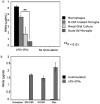Differential ex vivo nitric oxide production by acutely isolated neonatal and adult microglia
- PMID: 17698208
- PMCID: PMC2040026
- DOI: 10.1016/j.jneuroim.2007.07.004
Differential ex vivo nitric oxide production by acutely isolated neonatal and adult microglia
Abstract
Microglia are the macrophage population residing in the parenchyma of the central nervous system (CNS), and are thought to play critical roles in CNS development, homeostasis and defense against pathogens. Microglia are capable of rapidly responding to microbial pathogens through engagement of their Toll-like receptors (TLRs). We first compared the efficiency of these responses in primary microglia acutely isolated from adult and neonatal mice. While the cytokine and chemokine responses of adult microglia were generally higher than those of neonatal cells stimulated ex vivo through TLRs, the nitric oxide response of neonatal microglia was markedly enhanced relative to the adult cells. We then went on to identify culture conditions such as exposure to M-SCF or GM-CSF that markedly enhanced the nitric oxide response of microglia, particularly those from the adult CNS. Finally, we demonstrate that the differential nitric oxide response of neonatal and adult microglia is not only limited to the mouse, but also extends to rat microglia.
Figures







Similar articles
-
Highly purified lipoteichoic acid induced pro-inflammatory signalling in primary culture of rat microglia through Toll-like receptor 2: selective potentiation of nitric oxide production by muramyl dipeptide.J Neurochem. 2006 Oct;99(2):596-607. doi: 10.1111/j.1471-4159.2006.04085.x. Epub 2006 Jul 31. J Neurochem. 2006. PMID: 16879708
-
Release of prostaglandin E(2) and nitric oxide from spinal microglia is dependent on activation of p38 mitogen-activated protein kinase.Anesth Analg. 2010 Aug;111(2):554-60. doi: 10.1213/ANE.0b013e3181e3a2a2. Epub 2010 Jul 7. Anesth Analg. 2010. PMID: 20610553
-
Pro-inflammatory cytokines and lipopolysaccharide induce changes in cell morphology, and upregulation of ERK1/2, iNOS and sPLA₂-IIA expression in astrocytes and microglia.J Neuroinflammation. 2011 Sep 24;8:121. doi: 10.1186/1742-2094-8-121. J Neuroinflammation. 2011. PMID: 21943492 Free PMC article.
-
Pathological consequences of inducible nitric oxide synthase expression in hippocampal slice cultures.Neuroscience. 2005;135(4):1155-66. doi: 10.1016/j.neuroscience.2005.06.035. Epub 2005 Sep 13. Neuroscience. 2005. PMID: 16165295
-
Inhibition of inducible nitric oxide synthase expression by baicalein in endotoxin/cytokine-stimulated microglia.Biochem Pharmacol. 2004 Mar 1;67(5):957-65. doi: 10.1016/j.bcp.2003.10.010. Biochem Pharmacol. 2004. PMID: 15104249
Cited by
-
Inhibition of Colony Stimulating Factor 1 Receptor Suppresses Neuroinflammation and Neonatal Hypoxic-Ischemic Brain Injury.Front Neurol. 2021 Feb 18;12:607370. doi: 10.3389/fneur.2021.607370. eCollection 2021. Front Neurol. 2021. PMID: 33679579 Free PMC article.
-
Culturing microglia from the neonatal and adult central nervous system.J Vis Exp. 2013 Aug 9;(78):50647. doi: 10.3791/50647. J Vis Exp. 2013. PMID: 23962915 Free PMC article.
-
Development of a characterised tool kit for the interrogation of NLRP3 inflammasome-dependent responses.Sci Rep. 2018 Apr 4;8(1):5667. doi: 10.1038/s41598-018-24029-3. Sci Rep. 2018. PMID: 29618797 Free PMC article.
-
Biomaterial and Therapeutic Approaches for the Manipulation of Macrophage Phenotype in Peripheral and Central Nerve Repair.Pharmaceutics. 2021 Dec 15;13(12):2161. doi: 10.3390/pharmaceutics13122161. Pharmaceutics. 2021. PMID: 34959446 Free PMC article. Review.
-
Major histocompatibility complex haplotype determines hsp70-dependent protection against measles virus neurovirulence.J Virol. 2009 Jun;83(11):5544-55. doi: 10.1128/JVI.02673-08. Epub 2009 Mar 25. J Virol. 2009. PMID: 19321604 Free PMC article.
References
-
- Akagawa KS. Functional heterogeneity of colony-stimulating factor-induced human monocyte-derived macrophages. Int J Hematol. 2002;76:27–34. - PubMed
-
- Albina JE, Abate JA, Henry WL., Jr. Nitric oxide production is required for murine resident peritoneal macrophages to suppress mitogen-stimulated T cell proliferation. Role of IFN-gamma in the induction of the nitric oxide-synthesizing pathway. J Immunol. 1991;147:144–148. - PubMed
-
- Brannan CA, Roberts MR. Resident microglia from adult mice are refractory to nitric oxide-inducing stimuli due to impaired NOS2 gene expression. Glia. 2004;48:120–131. - PubMed
-
- Butovsky O, Ziv Y, Schwartz A, Landa G, Talpalar AE, Pluchino S, Martino G, Schwartz M. Microglia activated by IL-4 or IFN-gamma differentially induce neurogenesis and oligodendrogenesis from adult stem/progenitor cells. Mol Cell Neurosci. 2006;31:149–160. - PubMed
Publication types
MeSH terms
Substances
Grants and funding
LinkOut - more resources
Full Text Sources
Other Literature Sources

